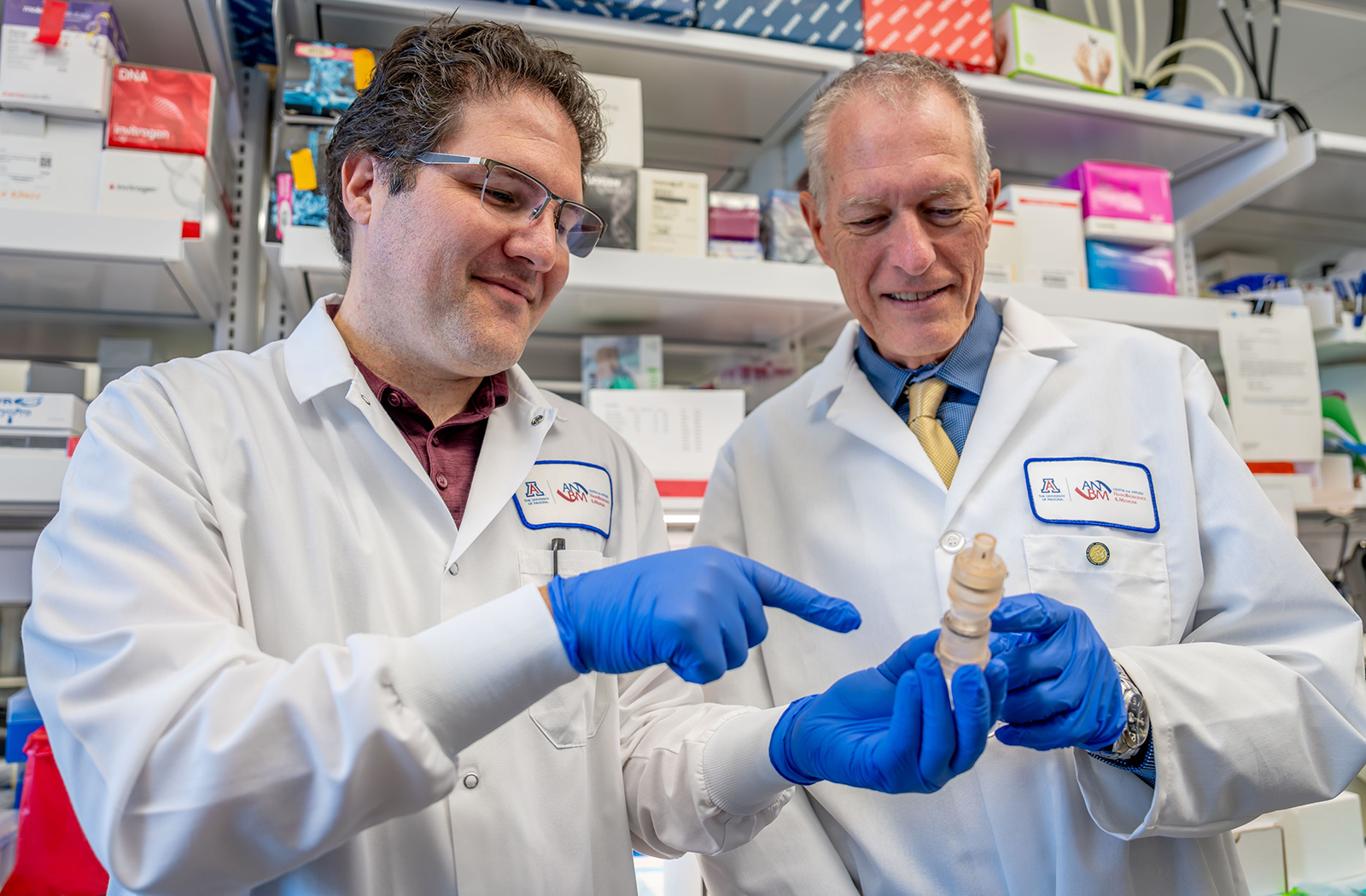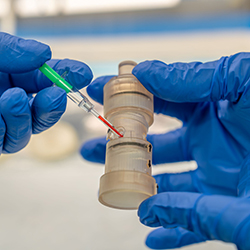
New Point-of-Care Device Can Identify Radiation Exposure Without the Need for Electricity

Frederic Zenhausern, PhD, MBA, director of the Center for Applied NanoBioscience and Medicine (ANBM) and a professor in the Department of Basic Medical Sciences at the University of Arizona College of Medicine – Phoenix — along with Jerome Lacombe, PhD, other ANBM engineers, and collaborators at the Columbia University’s Center for Radiological Research — developed the Self-Administrated Multiplex Universal Radiation Indication (SAMURAI) kit.
A device dedicated to measuring radiation exposure to ionizing radiations using panels of biomarkers of multiple transcripts and proteins with rapid results, it operates as a point-of-care device and includes an integrated sample preparation module to process whole blood samples from fingerstick collection. This allows for endpoint detection without the need of any ancillary readout instrument.
Sponsored by the National Institute of Allergy and Infectious Diseases through a new five-year contract under a U01 grant of about $2.7 million, SAMURAI could accelerate population triage with the precise measurement of radiation exposure threshold levels.
“The goal is to measure your exposure to radiation in a nuclear event or terrorist attack, but also this application can be translated into the clinical settings for radio therapy treatment management or monitoring astronauts during a space mission,” Dr. Zenhausern said. “The question is: How do you integrate and automate all the sample processing workflow from a blood-based sample to detect those multiplex biomarkers signatures and provide significantly more detailed biological information post-exposure than either method alone, offering a comprehensive view of the cellular stress response and ultimately improving biodosimetry and personalized treatment?”

The SAMURAI kit does not require electrical power to operate any instrumentation, which would lead to minimizing the size and cost of production, making it suitable for usage in low resources settings.
A continuation of previous research collaborations with SpaceX, and leveraging technological components developed under NASA and DoD contracts, the ANBM team anticipates creating a more universal point-of-care device for molecular genomic and proteomic analyses with a simple user-interface that can be used by anyone — whether they are on Earth, at home, in rural areas or in space.
“We have to ask if we can really integrate the sample preparation for both categories of biomolecules, protein and nucleic acid,” Dr. Zenhausern said. “That will open a lot of application of at-home molecular diagnostics devices, global health deployment and any type of mobile measurement. It could use in the battlefield, in a remote outpatient clinic or it could be used in spaceflight.”
Dr. Lacombe, an assistant professor in the Department of Basic Medical Sciences at the U of A College of Medicine – Phoenix, is co-leading this program with Dr. Zenhausern to develop this prototype and novel assay chemistries. He said the device could quantify the amount of radiation absorbed in the body through detecting protein and gene biomarkers.
“We are developing the SAMURAI device to process the blood, extract the proteins and the RNA from the cells, and then detect these proteins and RNA inside the device,” Dr. Lacombe said. “It is difficult to do this with a device that is power-free and can be used by anyone.”
SAMURAI will integrate all components required to perform sample collection and preparation, bioassay, detection, automated data analysis and reporting.
The core technology for it is a multiplex vertical flow assay (VFA), which has been patented and validated across multiple configurations and panels for viral, bacterial and toxin pathogens detection to cytokines in cell therapy monitoring. VFA is a more sensitive detection than devices that use single lateral flow immunoassay — a process typically used for COVID-19 testing or pregnancy testing.
According to Dr. Zenhausern, the simplicity and convenience of the SAMURAI kit’s interface allows the device’s results to be analytical to even untrained users, such as emergency first-responders or for self-testing by an individual at home.
“The endpoint detection is convenient because the array of spots printed on a paper membrane are representative of all the gene and protein biomarkers that can be seen with the naked eye,” Dr. Zenhausern said. “We also have a phone app that we can use to take a picture of that membrane and analyze those spots through an image analysis algorithm for further cloud-based interfacing with databases and cybersecure archiving”
Throughout the five-year contract, the ANBM team at will seek to optimize biodosimetry proteins and transcripts bioassays for paper-based format. They will also design and test a sample preparation module to extract proteins and gene transcripts from leucocytes, creating an integrated workflow protocol to transfer the extracts directly to the vertical flow assay detection module.
After the completion of the studies, Dr. Zenhausern and Dr. Lacombe anticipate that the potential of the SAMURAI kit will be adequately demonstrated and will integrate all components to detect comprehensive biomarkers in minimally invasive small volume of blood from fingerstick droplets and without electricity to power any instrument.
For future research, Dr. Zenhausern hopes the sensitivity of the device will allow for early detection and quantitative diagnosis of molecular markers of multiple diseases — including infection, cardiovascular and neurodegenerative diseases or cancer.
“The SAMURAI device is really the one that can enable tests at home, during bedside care or in any ambulance or emergency response,” Dr. Zenhausern said. “That multiple capability of testing almost any type of biomarker can open up barriers in diagnostics.”
About the College
Founded in 2007, the University of Arizona College of Medicine – Phoenix inspires and trains exemplary physicians, scientists and leaders to advance its core missions in education, research, clinical care and service to communities across Arizona. The college’s strength lies in our collaborations and partnerships with clinical affiliates, community organizations and industry sponsors. With our primary affiliate, Banner Health, we are recognized as the premier academic medical center in Phoenix. As an anchor institution of the Phoenix Bioscience Core, the college is home to signature research programs in neurosciences, cardiopulmonary diseases, immunology, informatics and metabolism. These focus areas uniquely position us to drive biomedical research and bolster economic development in the region.
As an urban institution with strong roots in rural and tribal health, the college has graduated more than 1,000 physicians and matriculates 130 students each year. Greater than 60% of matriculating students are from Arizona and many continue training at our GME sponsored residency programs, ultimately pursuing local academic and community-based opportunities. While our traditional four-year program continues to thrive, we will launch our recently approved accelerated three-year medical student curriculum with exclusive focus on primary care. This program is designed to further enhance workforce retention needs across Arizona.
The college has embarked on our strategic plan for 2025 to 2030. Learn more.